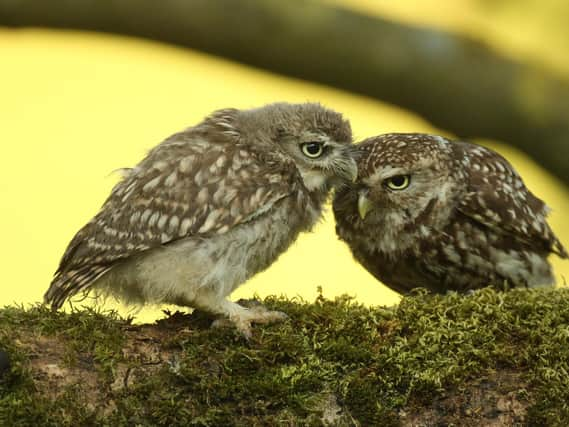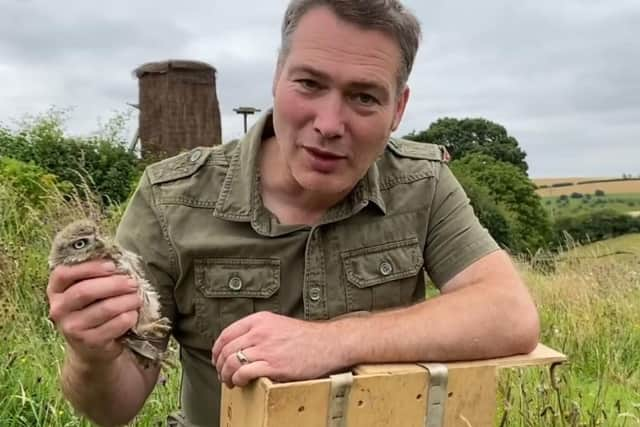Wildlife artist Robert Fuller has a new project to record the lives of little owls


The plan is still in its infancy and I have a lot to do before the breeding season begins.
Little owls stand at just 20cm tall and have piercing yellow eyes topped with light-coloured ‘brows’ that make them look as if they are permanently frowning. These cross expressions make them especially endearing.
Advertisement
Hide AdAdvertisement
Hide AdAs a boy I raised one by hand. Gizmo, as I named him, had fallen from his nest at just three weeks old and I took him into our home, fed him beetles and taught him to ride on the handlebars of my bicycle.


I was young then and didn’t know any better. Nowadays I would avoid hand-rearing a wild owl and instead try to restore a chick to its nest as soon as possible.
Which is how it was that I came upon a little owl family this summer. A worker on a neighbouring farm told me he had found an owl chick at the base of an ash tree and asked me to check it out.
It turned out that the owlet had fallen from a nest box I had put up myself years ago. Made from a fallen elm trunk it had stood empty for so long that I had almost given up on this box.
Advertisement
Hide AdAdvertisement
Hide AdArriving at the spot, I noticed the small fluffy chick near the roots of the ash. As I approached, it turned its head to look at me.
One of its eyes was closed and it was clear to see that the owl had a bad eye infection. Realising this wasn’t going to be a simple case of popping the owl chick back into its nest, I placed it carefully in a carry box ready to take home for treatment.
Before I headed home, I couldn’t resist taking a look inside the nest box to see if this little owl had any siblings
I propped my ladder against the ash, climbed up and carefully lifted the lid. Seeing three pairs of beady eyes staring back at me, I slowly closed the lid and retreated.
Advertisement
Hide AdAdvertisement
Hide AdBack at home I contacted Ryedale Rehabilitation for advice on how to treat the little owlet’s eye.
In the meantime, I set up a hide opposite the nest. I have photographed little owls at their nest at least five times before and I was excited at this new opportunity to watch the chicks before they fledged.
That evening I was settling into my new hide with my cameras when a little owl chick’s head popped out of the nest entrance, nodding inquisitively at the outside world.
I grabbed the first three cameras to hand and three little owls appeared, one for each of my cameras.
Advertisement
Hide AdAdvertisement
Hide AdIt was comical watching this trio of tiny owl heads jog up and down in the entrance to the owl box.
Their heads bobbed so vigorously they kept banging them on the top of the nest entrance. I had forgotten how much I loved watching little owls until this moment.
The peace was shattered by the raucous call of a crow. It landed in the tree above the owls and as it did so all three chicks peered up into the canopy, their eyes dilating and their feathers tightening against their bodies.
Then from a hawthorn bush to my left I heard an adult little owl call out a shrill warning.
Advertisement
Hide AdAdvertisement
Hide AdOn hearing this, the chicks rushed for cover. There was a flurry of feathers and fluff as they all tried to fit back through the small entrance hole at once and then at last, they were safely back in the nest.
I waved my hand out of the right-hand side of my hide and the crow took flight. I didn’t want it hanging around – I have seen crows try to kill little owl chicks before.
Not long afterwards the adult owl came into view and I watched it settle on a nearby branch and carefully preen its feathers.
Abruptly, it paused its preening and peered hard at the grass beneath my hide. Then the owl flew down, caught an orange underwing moth and flew up with it in its beak to feed the chicks.
Advertisement
Hide AdAdvertisement
Hide AdAfter devouring the moth, the chicks resumed their head-bobbing at the entrance to the nest box.
By the time I left the hide that night I was buzzing with excitement and couldn’t wait to return again the following night.
Over the following two weeks I treated the owlet at home with eye drops twice a day and visited the rest of the brood each evening.
It wasn’t long before the chicks became more confident and began taking their first, short, test flights around the ash tree.
Advertisement
Hide AdAdvertisement
Hide AdOccasionally, one would fall to the ground and climb right back up the tree, using its sharp talons to cling to the bark and flapping its wings as it fly-walked back to safety.
I have seen little owl chicks do this before and never fail to be amazed at their skill.
If they get tired, they simply hook their beaks into the bark to pause, before continuing to scale a vertical trunk.
It was two weeks before the owlet with the eye infection was well enough to return to the nest. I was worried its family may now not accept it back and so it was with some unease that I arrived early one evening to place the chick back into the nest.
Advertisement
Hide AdAdvertisement
Hide AdBut the owlet scurried through the entrance hole as if it had never been away and I retreated to my hide back to watch.
First two owl chicks emerged at the entrance, then the owlet I had just put back in was alongside them and all seemed well.
But then the fourth chick came out and the mood changed. This owlet began to peck at the feet of the newly recovered chick.
Within minutes the adult male arrived, but it too pecked and even head butted the newly-returned chick.
Advertisement
Hide AdAdvertisement
Hide AdI watched, helpless. After half an hour things were calmer and the adult began to feed grubs and worms to the chicks, but I noticed wasn’t giving any to the owlet I had reintroduced to the nest.
This chick flew up into the tree and the adult followed it, again trying to knock the chick over with its head.
The poor chick chittered in protest but then, gradually, and ever so gently, the pushing turned to preening.
I let out a huge sigh of a relief when I saw the chick fly back to the nest where the adult then fed it.
Advertisement
Hide AdAdvertisement
Hide AdLater that week all four chicks left the nest and took up residence together in an old rabbit hole further down the valley.
I won’t forget the sight of them standing together in the evening sun and then all diving for cover as I approached.
And I can’t wait to see if my plan to watch these gorgeous owls inside their nest pays off.
You can watch live footage from Robert’s owl cameras, including a live barn owl nest, on his YouTube channel, Robert E Fuller.